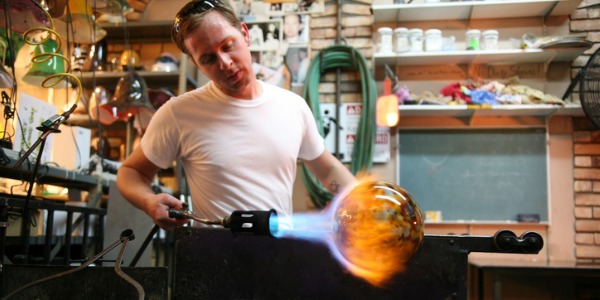What is a Glass Blower?
A glass blower creates designs ranging from simple to complex, using molten glass. Glass jars and vases, jewelry, art work, and figurines all may emerge from the end of a narrow tube, the skill and tools of the glass blower determining the final shape of the glass.
The art of glass blowing itself is an old one. It was in practice in the middle east as early as 20 BC, among the Phoenicians, when creating crude glass vessels sturdy enough to hold liquids was a great accomplishment. As practitioners became more skilled, artisans began experimenting with the creation of finely detailed and delicate blown glass that combined colours and shapes to form what amounted to works of art. Todays glass blowing techniques echo those of the past, with skilled workers using methods of glass creation that have been passed down through the generations.
What does a Glass Blower do?

In traditional glass blowing, molten glass is first created by heating a combination of soda ash, potash, limestone and sand to over 2000 degrees Fahrenheit (1093.3 Celcius.) When using the oldest technique, free-blowing, the glass blower spools a portion of molten glass on to the end of a blowpipe, forming a gather, or blob of molten glass. The blower then puffs air through the pipe to expand the glass into a bubble of the desired size. From this point, various tools are employed to produce the design the blower has envisioned.
The marver, a flat, thick steel surface, is used to cool and shape the glass. Tweezers, paddles, jacks and shears are used variously to pull out glass formations, flatten areas and cut and shape the glass. Glass that is not cooled properly can shatter dangerously due to thermal stress. Finished glass pieces are placed in an annealing oven to cool down at a safe temperature, a process that can take hours or days, depending on the size of the finished product. Individual glass blowers often develop their own workspaces and techniques, designed to suit their way of working, and methods of creation.
Modern glass workers, like those of old, create everything from speciality artwork to utilitarian items. Creating hand blow glass art in unique shapes or made-to-order is a staple of many glass studios, but some may also use a glass-molding technique to decrease work time and increase production of popular items. As the name implies, with glass-molding the molten glass is blown into a pre-made mold instead of being fashioned by hand.
What is the workplace of a Glass Blower like?
A glass blower's workplace can range from a small one or two-person shop to a large, industrial building. Many glass artisans are self-employed and work out of their own spaces, along with at least one helper and perhaps an apprentice. Since glass making requires three furnaces; a furnace, a crucible and the annealer - space is often at a premium in small studios. Work areas include the long, flat marver surfaces, often aligned at a height that allows the worker to stand as they roll and shape the glass.
Professional glass workers also work for large manufacturing firms, sometimes in a type of assembly line, performing one part of the glass creation process. Safety is an important consideration in glass blowing workplaces, as burns from molten glass can be severe and debilitating. Attention to detail, to surroundings and the patience to follow proper procedures are needed qualities for working safely as a glass blower.
Glass Blowers are also known as:
Glassblower
Glassmith